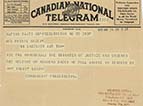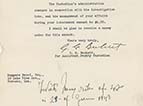Release
It is an established fact that all disciplined members of the Fascio are at the disposal of the Italian Government and its agents. Therefore, every release from internment will strengthen the hands of the enemy and make the situation with respect to civil and industrial security more precarious in this country.
S.T. Wood, RCMP Commissioner, letter to Minister of Justice E. Lapointe, April 25, 1941, Library and Archives Canada
Although on many occasions I have requested the production of some evidence to substantiate unsworn, and even unsigned allegations, with the exception of one of two instances, none has been produced, and against these allegations I have the sworn denials of the parties themselves, as well as evidence of highly placed individuals such as the Clergy, Members of Parliament, Doctors, Lawyers, etc. If the opinions of citizens such as these are not to be relied upon, I am at a loss to know what can be done in connection with this work.
J.D. Hyndman, Memo to Minister of Justice E. Lapointe, May 1, 1941, Library and Archives Canada
Release from camp occurred in a several ways:
Investigation
Under the DOCR (Defence of Canada Regulations), after 30 days, internees could formally object to their detention to an advisory committee appointed by the Minister of Justice. The Minister of Justice then appointed a judge to review the internee’s case. This meant an examination of the RCMP’s evidence against the internee, meetings with the internee, and interviews with witnesses who could attest to the internee’s character. After this, the judge either recommended an internee’s release or continued internment to the Minister of Justice. One of these judges was J.D. Hyndman, who often requested the release of internees he had interviewed.
The more affluent internees were able to hire lawyers to represent them during their hearings with an appointed judge. Legal counsel was not available to the majority of internees.
Compassionate Grounds
A release on compassionate grounds could occur if an internee was ill, an amputee, or suffered from partial paralysis. Montreal’s Ernesto Alovisi had undergone an operation as part of his cancer treatment prior to being interned. His recovery was affected by life at the camp, and he was released after seven weeks.
Mistaken Arrest
Agostino Badali, a 40-year-old fruit peddler from Toronto, was mistakenly arrested and interned because he shared the same name as a 25-year-old fascist also living in Toronto. Badali had been interned for three weeks before the error was discovered. He was released a week later. In the meantime, the younger Agostino Badali was arrested and sent to Petawawa. He remained interned until December 1941.
In a few cases, released internees were re-interned. However, it is unclear why this happened. It could be that these internees failed to properly follow their release conditions, such as reporting to RCMP before leaving their home city.
Most Italian Canadian internees were released well before the end of the war. The last internee released seems to be Nello Trasciatti, who was freed from Fredericton Internment Camp on July 6, 1945.



